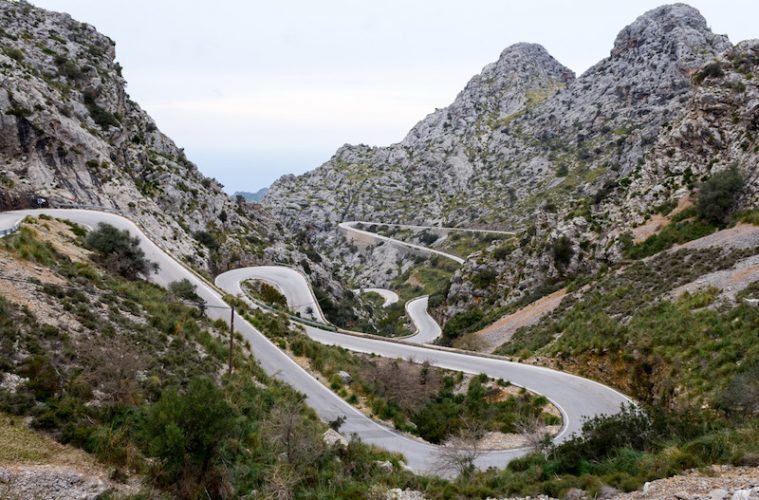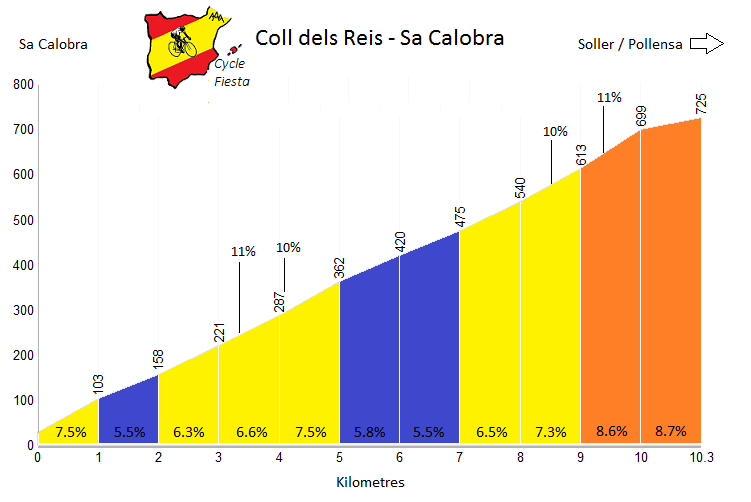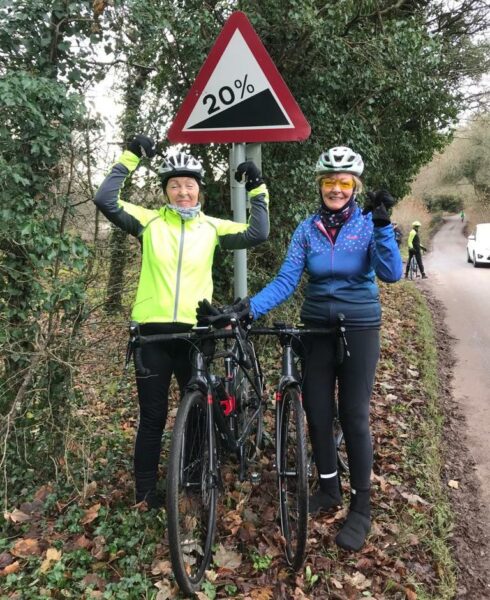Cycling By Numbers – Hill Repeats
With winter now starting you have to be a masochist to enjoy long rides on cold and frosty mornings. That is when short rides, concentrating on our local hills come to the fore. There is little that improves our overall fitness more, and is guaranteed to keep you warm, than climbing hills!
A couple of years back, before Covid spoilt their plans, some of our ladies had decided to go to the cyclists’ mecca of Mallorca. The biggest challenge that they had set themselves, was to climb up the infamous Sa Calobra – The Serpent.

But the above is just part of this serpentine, monster climb. First they have to get there – a long and hilly ride from their hotel. Having arrived at the top of Sa Calobra, they have to weave their way down, at speed, around the multiple hairpin bends, to the little bay at the bottom of the hill. Then start the climb back from sea level, and it is then, all up for 10.3 km (6 miles). Although the statistics say the average gradient is “only” 6.5%, the numbers appear to tell a different story. As you can see from the profile below, there are sections where the gradient increases to 10 and 11%. And if that is not enough, there is one short section where it hits 20%!

Now, after two summers lost due to Covid, our ladies have decided that Sa Calobra is back on the agenda for 2022. So a priority over the coming months must be hill training. We are fortunate that we are surrounded by hills. So their club rides should obviously take advantage of these. With the winter weather, rides of 20 to 40 miles to and from tea stops, should include as many hills as practical. And not forgetting to include a few short, hard sprints to train the type IIB muscle fibres to enhance power and strength for the 20% sections of climbs!
And this was Denise and Jo when they started their hill training for Sa Calobra, back in 2019 – the climb on the road towards Polsden Lacey.

But the main focus should be on specific training in preparation for that 6 mile climb up Sa Calobra. We don’t have long, 6 mile climbs in and around our area, so how do we go about putting this training into practise?
You might think that the answer is to do shorter efforts at higher intensities, but all that means, is that you will be able to go out harder, before faltering on those longer climbs. The key is not training to go faster, but to train not to slow down.
This is best achieved by some extended training at Tempo pace. The ultimate aim of which, is to be able to sustain a tempo paced intensity on the climbs, for an hour or more.
To do this, the training sessions should start off conservatively, with say two or three 10 minute Tempo pace intervals with five minutes of gently paced recovery in between the efforts. Then over the weeks, progressively work the way up to 3 or 4 x 12 to 15 minute intervals. This will then get us up to an accumulated total of an hour’s climbing, but using our shorter local hills.
Climbing a hill at Tempo pace teaches our muscles to recruit more fibres. This results in more power and better fuel economy. Working at a moderate intensity makes it an easier and a more fun way of doing a workout. You don’t need to hammer. Just get the pace up to where you are breathing a little harder, whilst still being able to keep talking to your friends, but only in shorter sentences.

To avoid boredom doing repeats on the same hill, we have several different hills to train on. For example, Box Hill; Ide Hill and Toys Hill from Brasted to the top; and Beddlestead Lane, are all approx 2 mile climbs and take about 10 minutes to climb. At the top of the climb, an easy pedal back to the bottom to provide the 5 minute recovery, and then start the next repeat hill climb. Three such repeats gives us the target climb of circa 10km/6 miles, with of course Beddlestead being the easiest of the climbs, to start with.
All training should be progressive, so when the above suggested 4 x 15 minute repeats have been achieved, the next step up is to increase the intensity with “Sweet Spot” intervals/repeats. But that can wait until we have completed this first phase of training.
There is a more detailed article about Tempo training in the winter, and the benefits of Tempo training, here https://fascatcoaching.com/blogs/training-tips/tempo-training
You may wonder what “Tempo Pace” and “Sweet Spot Zone” mean, and what they feel like – the RPE or Rate of Perceived Exertion. You can judge the level of exertion by paying attention to your breathing – so see below. The greater the intensity, the deeper your breathing will become. If you get to a level where you are so short of breath that you can’t talk – slow down! You are way out of the training zone and will not achieve the intended benefits of Tempo Training.
Zone 3: Tempo pace
Hill climbing & headwind pace, RPE 3 – 4
You can talk in short sentences but can’t whistle. This pace trains the aerobic system to burn glycogen (from carbs) & improves your cruising speed. You should climb most of the time in this zone or lower. You’ll have better endurance if you climb here instead of climbing harder and then taking time in zone 1 to recover.
Power Pace (Sweet Spot)
Sweet spot, RPE 4 – 5
You can talk in short phrases but not short sentences. The Sweet Spot is the upper end of zone 3 and the lower end of zone 4. Riding in this range is just before you start to go significantly anaerobic. Riding in zone 4 will produce more training overload, but require significantly more recovery. Thus the Sweet Spot is the optimal place to train to increase power – but after you have completed an adequate amount of training at Tempo Pace.
But the most important thing about any training programme, is to do it. Not just read about it!
Des

